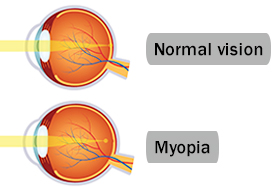
What causes myopia?
Myopia or nearsightedness is generally caused by the eyeball growing too quickly. This causes light to enter the eye and focus in front of the retina which causes distance vision to be blurry.
What are risk factors for becoming myopic or nearsighted?
Age – One of the single greatest predictors is the age at which the onset of myopia occurs. The younger the patient is at onset, the greater the likelihood of faster progression and overall amount of myopia.
Ethnicity – Studies show that patients of Asian ethnicity have a greater risk of becoming myopic.
Genetics – Studies refer to this as “parental myopia”. Children with 1 myopic parent have a 2-3x greater chance of becoming myopic and a 6x greater chance if both parents are myopic.
Environmental Factors – It is thought that increased near work (reading, computers, or handheld devices) may be a risk factor for developing myopia. There are also theories regarding time spent outdoors. Studies show that increasing outdoor time may help prevent the ONSET of myopia, however once a child becomes myopic, outdoor time does not seem to prevent the PROGRESSION of myopia.
What are some tips to do at home to help reduce the risk of children becoming myopic or slowing the progression if they already are myopic?
Take regular breaks from reading – (the 20/20 rule) For every 20 minutes of reading, take a 20 second break and look across the room. This helps relax the focusing muscles in the eyes after reading.
Don’t hold reading material or screens too close – a good rule is to keep reading material an elbow to wrist distance from the eyes.
Try to limit “extra-curricular” screen time to two hours per day in school aged children.
















